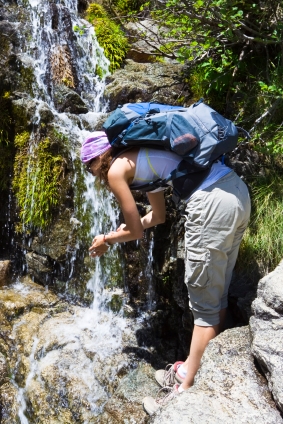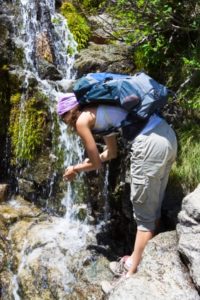It’s time to think about fitness for backpacking.
Throughout the cold winter, you dragged yourself into the gym and resisted becoming a couch potato, lifted weights, walked the treadmill, and maybe took a fitness class or two. Now that the spring flowers have bloomed and you’re thinking of adventure sports and backpacking.
Be careful. You’re in great shape, sure, and haven’t put on any weight this winter, but it’s worth remembering that backpacking will place a different type of strain on your body calling on muscles you haven’t used since last season. Most gym equipment doesn’t require much use of your balancing and stabilizing muscles. Prepare your body before loading up that backpack.
Now is the time to adjust your workout, preparing your body for the rigors of uneven terrain. Here are a few tips to avoid injury and have an enjoyable hike:
1) Start in the gym before moving to the trail. Incorporate moves that involve balance and recruit multiple muscle groups. Good examples are lunges, squats, calf raises and push-ups. These tried-and-true exercises combined with newer ones, such as squats on a BOSU Balance Trainer (a platform mounted to half of a stability ball), comprise a solid balance building routine. Google “balance building exercises” for more ideas.
On a treadmill, use incline-intervals, raising or lowering the machine every couple of minutes, steadily increasing the maximum incline with each workout. Some treadmills have a built-in “hill” program that does this automatically, or you can raise and lower it manually. If the treadmill has a decline setting, such as a Nordic Track, use it to prepare your legs and knees for downhill trail sections. Note: Do not use the handrails except briefly; it decreases the effectiveness of your workout.
Add a yoga or Pilates class to your routine to improve flexibility and core strength.
This is a good time to spend money on a personal trainer to assist you with adjusting your workout for backpacking. An experienced trainer can design a custom routine built around your ability and goals, and make sure you execute it safely.
2) Don’t get over ambitious, begin hiking locally without the weight of a backpack. If you haven’t broken in your boots, now is the time. Each person is different as to how long these first hikes should be. Three- or four-mile hikes are a good start, especially if breaking-in boots at the same time. If the first hike isn’t challenging, extend the next hike to six to eight miles.
Proper nutrition is very important while backpacking. A 160-pound backpacker will burn an average of 4100 calories per day, according to the Mayo Clinic. Experiment with different foods to find which keep your energy high so you know what to pack on your first multi-day trip. Complex carbohydrates provide sustained energy, while simple carbohydrates give a quick boost of energy for climbing that monster uphill section. Carry some of each. For snack and meal ideas read my post, Three Cookbooks for Backpacking. I will cover trail food in more depth and detail over the coming weeks.
3) Finally, once you are able to hike nine to 10 miles comfortably, add a weighted pack. Start with roughly 20 percent of your body weight or 30 pounds, whichever is less. Load your backpack with gear until it’s the desired weight and drop your distance back to between four to six miles. Progressively build up to a nine- to a 10-mile hike with a fully loaded pack and you’ll be ready to plan your multi-day trip.
Allow four to six weeks to build your strength and endurance. As mentioned in the opening, this program is an extension of a regular fitness routine. If you took the winter off from the gym, plan to spend additional time conditioning before your first backpacking trip.
Enjoy this post? Read all of my adventure health and fitness posts HERE.


Comments 16
This is all the great info. With my first thru-hike of Vermont’s Long Trail scheduled for September, I am looking forward to your planning and logistics recommendations.
That sounds like a great adventure! I would love to hear about it when you’re done!
Great suggestions!
Thanks Ben!
I just happened upon your blog from Travel Blog Exchange. I’m super excited to read more. I’d love to do a portion of the AT this season. Good luck with your training!
You really should do it! I didn’t hike the AT for a long time because I heard its crowded, but its really not bad.
Good tips. Another good one is cross-country ski in the offseason. I actually get in better shape in winter due to skiing, so I never have a problem when it is hiking season again.
Great suggestion! I have really been wanting to try cross-country skiing or snowshoeing.
I hope you have a great trip!
Thanks Lisa! We leave next Sunday.
This all very helpful information. We’re in the process of practicing and learning what it takes to backpack into overnight camping spots with our baby. This is great advice, thanks!
I’m glad you found a few useful tips here. Please let me know how your trips go, I would love to hear!
Pingback: An open letter to my readers…
Pingback: From gym to trail: Adjust your workout for backpacking | Odyssey Treks
i am 60 yrs old & did my first back packing trip last year. Even though I trained a lot, carrying my :45 # backpack 5 miles was really hard…. But I loved it!
Can you give me some tips on how to pack lighter? I want to do another trip this year that’s 5-8 miles a day. So I’d like to get my pack down to about 25 #
Thanks!
Chris
Hi Chris, I agree that 45# is a lot. I average under 30# in the spring months. I weigh everything on a kitchen scale, and found that upgrading a lot of my old heavy gear made the biggest difference. The weight of the pack itself is something to watch too. I do without a lot of comforts, such as a towel, chair, etc. I carry two shirts and two bottoms for even long trips, yes I smell and that’s okay. Some only carry what they wear. All that said, I’d start with a look at how heavy your stuff is and see if a big weight saving could come from replacing some pieces.